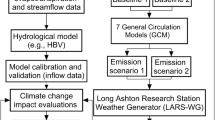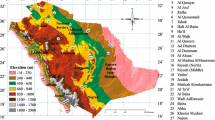Abstract
Decadal climate change has evidently posed serious threats and challenges to water resource management across arid regions in China. Thus, vulnerability assessment of water resources has been considered vital to adapt to or cope with the adverse effects of climate change. This paper investigated spatial patterns of decadal climate change and water resources variability in the arid regions of Northwest China based on a GIS analysis. The Budyko hypothesis was used to investigate the climate sensitivity of basin streamflow. A framework was proposed to assess the vulnerability of water resources as a function of exposure, sensitivity, and adaptability. Results indicated that a significant increase in precipitation and water resources (both surface water resources and groundwater recharge) occurred primarily in Xinjiang Province after the 1980s. Water utilization ratio in arid regions was very high, and groundwater abstraction substantially increased as it exceeded the exploitable volume in the Hexi Corridor, the Tuha Basin, and the north of the Tianshan Mountain. Exposure of water resources to drought in arid regions decreased from the 1960s to the 2000s. The sensitivity of water resource response to precipitation changes varied between regions. Water resources were more sensitive to precipitation variability in the river basins in the Hexi Corridor and inner Mongolia. In most arid regions in China, water resources were evaluated with low adaptability and high or severe vulnerability in the 2000s. In the future, the precipitation is projected to increase significantly under the RCP2.6, RCP4.5, and RCP8.5 scenarios. Particularly, water vulnerability will be significantly reduced as the precipitation increases in most river basins under the RCP8.5 scenario. Water resources in the rivers in the Qaidam Basin, the Qinhai Lake Basin, the inner Mongolia, and the north of Kunlun Mountain will have low or medium vulnerability in the 2030s and 2050s. However, in the Tuha Basin and Hexi Corridor, vulnerability will remain severe in the 2050s despite the significant increase in precipitation and implementation of water-saving measures. Hence, measures that will facilitate sustainable water resource management must be identified and implemented.














Similar content being viewed by others
References
Adger N, Aggarwal P, Agrawala S, Alcamo J, Allali A, Anisimov O, Arnell N, Boko M et al (2007) Climate change 2007: impacts, adaptation and vulnerability: working group II contribution to the fourth assessment report of the ipcc intergovernmental panel on climate change. Cambridge University Press, Cambridge
Arnell NW (1999) Climate change and global water resources. Glob Environ Chang 9:S31–S49
Babel MS, Wahid SM (2009) Freshwater under threat: South Asia—vulnerability assessment of freshwater resources to environmental change. United Nations Environment Programme and Asian Institute of Technology, Bangkok
Bao C, Fang CL (2007) Water resources constraint force on urbanization in water deficient regions: a case study of the Hexi Corridor, arid area of NW China. Ecol Econ 62(3):508–517
Brown A, Matlock MD (2011) A review of water scarcity indices and methodologies. University of Arkansas, Arkansas, USA. The Sustainability Consortium, White Paper, 106
Budyko MI, Miller DH (1974) Climate and life. Academic press, New York, p 508
Cui G, Lee S, Lee W, Chung J (2010) Vulnerability assessment of water resources to climate change using GIS. ESRI international user conference, San Diego
Deng XP, Shan L, Zhang H, Turner NC (2006) Improving agricultural water use efficiency in arid and semiarid areas of China. Agric Water Manag 80(1):23–40
Dong XN, Li XM, Jia XP, Wang YM, Jiang XH (2006) Water resources investigation in Northwest China. Yellow River Conservancy Press (in Chinese)
DonohueRJ RoderickML, McVicar TR (2011) Assessing the differences in sensitivities of runoff to changes in climatic conditions across a large basin. J Hydrol 406(3):234–244
Falkenmark M (1989) The massive water scarcity now threatening Africa: why isn’t it being addressed? Ambio 112–118
FellmannT, Lankoski J (2012) FAO/OECD workshop. Red, vol 23, p 24
FengQ ChengGD, Masao MK (2000) Trends of water resource development and utilization in arid north-west China. Environ Geol 39(8):831–838
Fu BP (1981) On the calculation of the evaporation from land surface. Chin J Atmos Sci 1:002
Füssel HM (2007) Vulnerability: a generally applicable conceptual framework for climate change research. Glob Environ Chang 17(2):155–167
Heltberg R, Bonch-Osmolovskiy M (2011) Mapping vulnerability to climate change. World Bank Policy Research Working Paper Series
Liu CZ (2003) The vulnerability of water resources in Northwest China. J Glaciol Geocryol 25(6):309–314
Ma Z, Fu C (2006) Some evidence of drying trend over northern China from 1951 to 2004. Chin Sci Bull 51(23):2913–2925
Ma Z, Kang S, Zhang L, Tong L, Su X (2008) Analysis of impacts of climate variability and human activity on streamflow for a river basin in arid region of northwest China. J Hydrol 352(3):239–249
Mansur S, Rahman Y (2007) Analysis on the spatial and temporal changes of population and its influencing factors in Xinjiang in the Last 50 years. Hum Geogr 6:114–120 (in Chinese)
McCaffrey SC (1992) A human right to water: domestic and international implications. Georget Int Environ Law Rev 5:1
McNabb DE (2005) Public utilities: management challenges for the 21st century. Edward Elgar Publishing
Smit B, Pilifosova O (2003) Adaptation to climate change in the context of sustainable development and equity. Sustain Dev 8(9):9
Smit B, Wandel J (2006) Adaptation, adaptive capacity and vulnerability. Glob Environ Change 16(3):282–292
Sullivan CA, Huntingford C (2009) Water resources, climate change and human vulnerability. Paper presented at the 18th World IMACS/MODSIM Congress, Cairns/Australia
Vörösmarty CJ, Green P, Salisbury J, Lammers RB (2000) Global water resources: vulnerability from climate change and population growth. Science 289(5477):284
Wang G, Cheng G (2000) The characteristics of water resources and the changes of the hydrological process and environment in the arid zone of Northwest China. Environ Geol 39(7):783–790
Watson RT, Zinyowera MC, Moss RH (1998) The regional impacts of climate change: an assessment of vulnerability. Cambridge University Press, Cambridge
Xia J, Chen YD (2001) Water problems and opportunities in the hydrological sciences in China. Hydrol Sci J 46(6):907–921
Xiao SJ, Li QJ, Liu ZS, Wang HJ (2011) Water demand prediction of social and economic development of the river regions in the Northwest China. Yellow River 33(11):77–80 (in Chinese)
Zhang Y, Zhang S, Xia J, Hua D (2013) Temporal and spatial variation of the main water balance components in the three rivers source region, China from 1960 to 2000. Environ Earth Sci 68(4):973–983
Acknowledgments
This work was supported by the National Program on Key Basic Research Project (973 Program, 2012CB956204/2010CB428406). We acknowledge the modelling groups for providing their data for analysis, the Program for Climate Model Diagnosis and Intercomparison (PCMDI) and the World Climate Research Programme’s (WCRP’s) Coupled Model Intercomparison Project for collecting and archiving the model output, organizing the model data analysis activity. The data has been collected analyzed, and are provided by National Climate Center.
Author information
Authors and Affiliations
Corresponding author
Rights and permissions
About this article
Cite this article
Wan, L., Xia, J., Hong, S. et al. Decadal climate variability and vulnerability of water resources in arid regions of Northwest China. Environ Earth Sci 73, 6539–6552 (2015). https://doi.org/10.1007/s12665-014-3874-5
Received:
Accepted:
Published:
Issue Date:
DOI: https://doi.org/10.1007/s12665-014-3874-5




